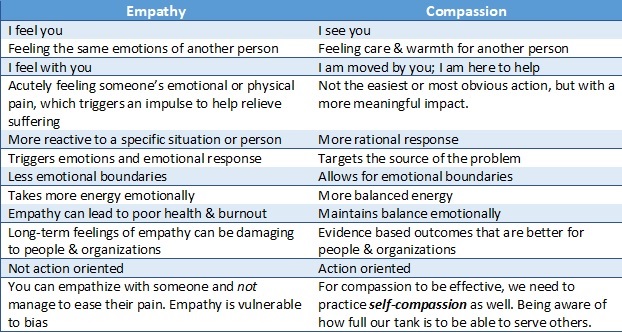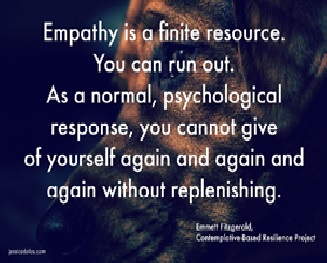What are the differences?
Compassion and Empathy are being talked about a lot in the work environment these days. I have discovered that many of us, myself included, sometimes use these words interchangeably, so that their definitions have become blurred. However, the definitions of Compassion and Empathy are quite different!
Empathy and Compassion have a similar intention: to understand someone else and how they may be feeling. As a leader, it is important to understand the difference and be intentional with your way of being. You should know whether you are being empathetic or compassionate at any given time. Let’s look at the differences between Empathy and Compassion.

Check your own focus

Pause and Reflect: Think about where you spend your time, being empathetic or being compassionate. As a leader today, it is healthier for you to be compassionate more often than empathetic, simply from an energy standpoint. Being empathetic takes much more energy and it’s not as action oriented.
While empathy refers more generally to our ability to take the perspective of and feel the emotions of another person, compassion is when those feelings and thoughts include the desire to help. Being a compassionate leader has shown to build effective leadership, drive performance and improve the customer experience. Development Dimensions International estimates that 20% of employers offer this kind of training as part of their development initiatives. What kind of empathy and compassion training is happening in your organization? How can you bring this kind of training into your organization?
Compassionate Leadership
A wonderful book, “I Love it Here” by Clint Pulver talks about the importance of being a Mentor Manager, which he further describes as “being a manager who manages with empathy and expectations. A manager’s ability being able to relate to and connect with their staff is as important to an employee’s engagement level as that manager’s level of expectations and standards.”
Let’s be clear, being a compassionate leader does not mean we don’t hold people accountable to expectations, standards, and goals. It means we are also bringing the human side to conversations and coaching with staff members. As a result of taking time to connect with your staff, you create a culture of trust, kindness, and care – along with getting things done!
Your Leadership Challenge

Take the time to evaluate your leadership style. How often do you bring Compassionate Leadership to your everyday interactions and conversations with your staff members? How can you bring more Compassionate Leadership into your culture? Check in with your staff members, do they have clear expectations and understand the rules and guidelines while at the same time feeling valued and cared for? Do they feel and know YOU care? Instead of asking “How do I keep my staff?”, perhaps these are better questions to ask:
- What is my staff feeling right now?
- How do they want to be treated?
- What can I do to inspire them?
- How can we create a culture they love and protect?
Excellent Article: Leaders Connect with Empathy but Lead with Compassion
Related blog: Using Empathy in Times of Stress (i.e., the Pandemic)



Helpful and timely article. The grid is a great resource. Thank you Marguerite!